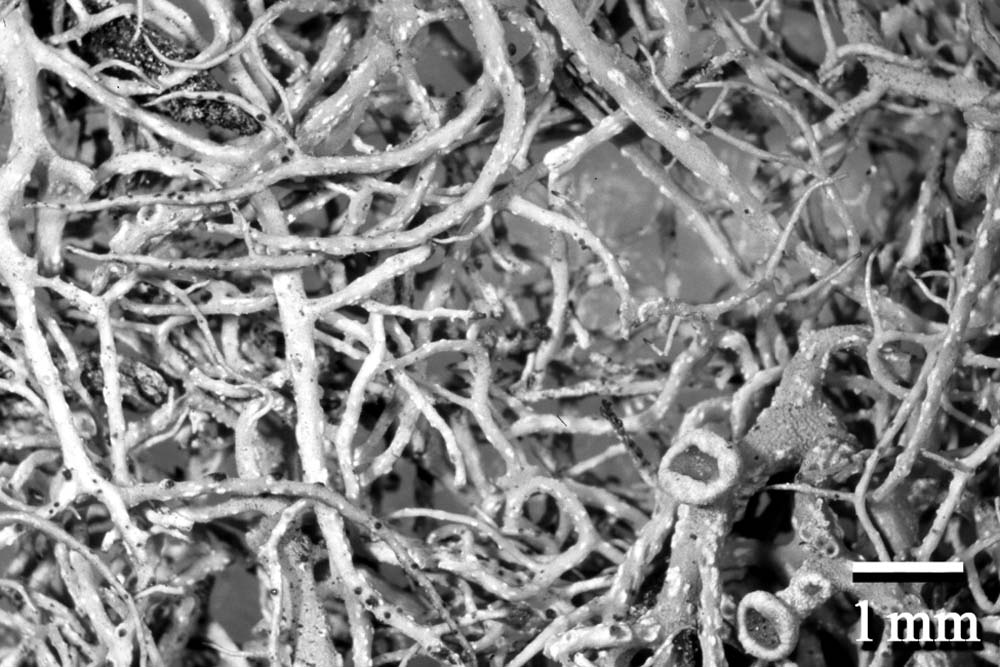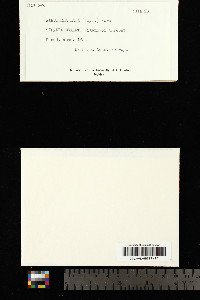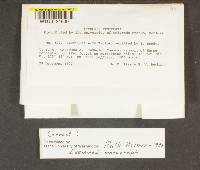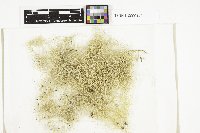
Consortium of Lichen Herbaria
- building a Global Consortium of Bryophytes and Lichens as keystones of cryptobiotic communities -
- Home
- Search
- Images
- Species Checklists
- US States: O-Z >
- US National Parks
- Central America
- South America
- US National Parks
- Southern Subpolar Region
|
|
|
|
Family: Parmeliaceae
[Alectoria osteina Nyl., moreCornicularia lata Taylor] |
Nash, T.H., Ryan, B.D., Gries, C., Bungartz, F., (eds.) 2002. Lichen Flora of the Greater Sonoran Desert Region. Vol 1. Thallus: caespitose [to subpendent in non-Sonoran material], occasionally prostrate and entangled, stiff, 1.5-2 cm long [usually 5-8 cm long in non-Sonoran material], apparently dying at the base [looser and more irregular, often with persistent base, in non-Sonoran material] branching: mainly isotomic dichotomous from the base, sometimes becoming anisotomic dichotomous towards the apices, sometimes with short perpendicular lateral branches; axils: mostly acute; ultimate branchlets sometimes curved but not distinctly drooping branches: terete [usually somewhat angular in cross-section in non-Sonoran region material], not flattened, even to uneven in diam., 0.5-1.5 (-2.0) mm diam. surface: grayish green to pale greenish yellow throughout [in non-Sonoran material, more distinctly yellow or green, without grayish cast, and sometimes streaked greenish-black, especially towards the base]; soralia: absent; true lateral spinules absent; pseudocyphellae: white, raised, ± abundant and conspicuous, mostly ellipsoid and 0.1-0.2 mm long [in non-Sonoran region material, elongate fusiform and mainly 0.5-1.0 mm long], without isidia-like spinules Apothecia: frequent, lateral but sometimes appearing geniculate due to the death or disintegration of the branch distal to the ascocarps, (0.6-) 2-4 mm in diam. [to 10 mm elsewhere]; thalline exciple: concolorous with thallus, incurved; disc: light yellowish brown to grayish yellowish brown [brown to black in non-Sonoran material], concave to plane asci: clavate-oval, 2-spored ascospores: ellipsoid, simple, 35-45 x 18-24 micro meters Pycnidia: not seen Spot tests: cortex K- or sometimes K+ red, C- or sometimes C+ green-black, KC+ yellow, P-, UV-; medulla K-, C-, KC+ red, CK-, P-, UV+ ice-blue Secondary metabolites: cortex: with usnic acid and occasionally a K+ red unknown; medulla with alectoronic acid. Substrate and ecology: on pine bark in oak-pine and oak-pine-cypress forests, elsewhere also on soil or rock, usually at high altitudes World distribution: western North America (central Mexican highlands northward along the Sierra Madre Occidental, then disjunct to the Cascade range in Pacific NW), Central America (Guatemala) and eastern Asia Sonoran distribution: Chihuahua and Sinaloa, 1800-2300 m. Notes: Although the material from the Sonoran region differs in some respects from the description given by Brodo and Hawksworth (1977), it clearly fits A. lata in chemistry, ascospores, and various other features. The species was originally described from Mexico and was previously reported from Chihuahua. It differs from A. sarmentosa, with which it can sometimes be confused, by its caespitose habit, its generally more abundant ascocarps and its larger spores. It differs from A. mexicana in chemistry (C-, with alectoronic rather than olivetoric acid; both KC+ red), and in its mainly acute axils, and ± concave discs. Brodo and Hawksworth (1977) described A. mexicana as being ± pendent and 10-12 (-22) cm long, but an examination of a set of Beharrel collections from Oaxaca suggests that the species can be much shorter and caespitose. The ASU exsiccati, distributed as A. mexicana, from Chihuahua, contain alectorialic rather than olivetoric acid, and are included here under A. lata. |
Powered by Symbiota

































